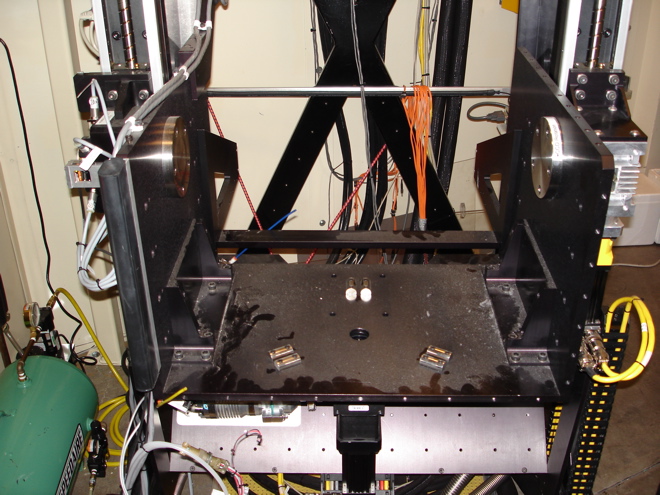Our detector is gone!
It’s gone! We boxed up our Q315 yesterday and sent it back to ADSC for an upgrade to the Q315r model.

Essentially this is an upgrade to the amplifiers that read out the CCDs and the other associated electronics for getting the raw images to the detector computers for processing. The fiber optic tapers and CCDs will not be replaced. The overall benefits of this upgrade are an decrease in read-out noise, an increase in speed, and the ability to use stored dark current images. Here are some excerpts from a detailed comparison performed by James Holton:
ampgain eo_gain readnoise pixel fog photons allowable detector e-/ADU e-/photon e-/pixel um /100um2 redundancy ---------------------------------------------------------------------- Q315 12 7.3 27(swbin) 102.4 12.4 1.00 Q315 4 7.3 16(hwbin) 102.4 4.37 2.85 Q315R 4 7.3 11.5 102.4 2.26 5.51 M300HE 4? 11 7.7 73.2 1.71 7.29"fog photons"/pixel is the number of extra background photons/pixel required to increase the noise in a pixel by the same amount as the read noise. Since the "fog photons" will add with redundancy, the far right column shows how many fold more images (relative to a Q315) you can spread the same total x-ray exposure over and get the same total read noise (as if you collected the data with "unit" redundancy on a Q315). The Q315R will allow 5.5x more images than what we are doing now: 12 "fog photons"/pixel on a Q315 in swbin mode.
James goes on to compare the relative crysal sizes that will produce equivalent diffraction:
All things being equal (including the extent of radiation damage), the intensity of the spots and background are proportional to the crystal volume. Doubling the crystal volume will double the signal (spot intensity) as well as double the background (in the ideal case of a "naked crystal" with no air scatter or other sources of background). So doubling the crystal volume makes the noise (sqrt(signal+background)) go up by no more than sqrt(2). Unless the crystal is bigger than the beam, or it is so thick that it attenuates the beam, radiation damage will be proportional to photons/um2, which has nothing to do with the crystal size. This means that, for the same extent of damage, the signal/noise ratio goes as size^(3/2) if "size" is the linear dimension of the crystal. That is, doubling the linear dimension of a "round" crystal will nearly triple the signal/noise (2.83x), and a 10% increase in the "size" (linear dimension) will increase signal/noise by 15%.
If we have some high-res spot with I/sig(I)=2 in the absence of any background or read noise, then there are (on average) 4 photons in that spot (4/sqrt(4) = 2). Spots typically take up on the order of 25 pixels. So, adding 0.1 "fog photon"/pixel (as on a Mar300HE) will make I/sig(I) of this spot drop from 2.0 to 4/sqrt(4+25*0.1) = 1.6. Increasing the crystal size by 12.5% will increase the crystal volume by 42% and put 5.7 photons into this same spot (for the same exposure time and therefore the same amount of radiation damage) and bring I/sig(I) back up to 5.7/sqrt(5.7+25*0.1) = 2.0. This means that the crystal size needed to achieve a given resolution limit on the Mar300HE is 12.5% larger than the crystal size needed to achieve the same resolution with an ideal photon-counting detector (such as the Pilatus). This is assuming there are no other sources of noise, including x-ray background.
Changing the read noise to 2 "fog photons"/pixel will make the I/sig(I) of this 5.7-photon spot drop from 2 to (5.7/sqrt(5.7+25*2)) = 0.76. Bringing the signal up to 16.3 photons/spot will bring I/sig(I) up to 2.0 again. This represents a ~3-fold increase in crystal volume (16.3/5.7=2.86) and a 42% increase in crystal size. To put it another way, using the Mar300HE instead of a Q315R would let us get away with crystals 30% smaller in linear dimension for a given resolution limit (and given amount of damage). Going from a Q315R to a Q315 (with 21 "fog photons"/pixel) will require 47.9 photons in the spot (47.9/sqrt(47.9+25*21) = 2.0) and another 43% increase
detector photons/spot xtalsize perfect 4.0 0.63 or -37% M300HE 5.7 0.71 or -29% Q270 7.8 0.78 or -22% M300 12.2 0.91 or -9% Q315R 16.3 1.00 Q315 47.9 1.43 or +43%
The take home message is that our new Q315r will be way better than that old Q315 peice of junk. We will now collect more accurate data in less time with smaller crystals.